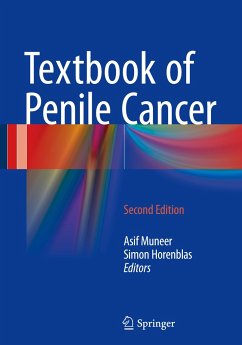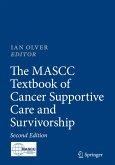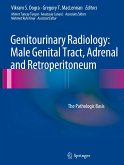Textbook of Penile Cancer
Herausgegeben:Muneer, Asif; Horenblas, Simon
Textbook of Penile Cancer
Herausgegeben:Muneer, Asif; Horenblas, Simon
- Gebundenes Buch
- Merkliste
- Auf die Merkliste
- Bewerten Bewerten
- Teilen
- Produkt teilen
- Produkterinnerung
- Produkterinnerung
The aim of the updated book is to include new developments and update the literature in relation to sentinel node biopsy, new radiology techniques and long term epidemiological data. This book is useful for urologists, dermatologists, sexual health physicians as well as those with an interest in virology and genomics related to squamous cell cancers.
The surgical techniques are all well illustrated with a step by step guide in order to allow those individuals in centres which are not expert centres to undertake the management of this devastating tumour.
Andere Kunden interessierten sich auch für
![Textbook of Penile Cancer Textbook of Penile Cancer]() Textbook of Penile Cancer90,99 €
Textbook of Penile Cancer90,99 €![Penile Disorders Penile Disorders]() Penile Disorders38,99 €
Penile Disorders38,99 €![The MASCC Textbook of Cancer Supportive Care and Survivorship The MASCC Textbook of Cancer Supportive Care and Survivorship]() The MASCC Textbook of Cancer Supportive Care and Survivorship172,99 €
The MASCC Textbook of Cancer Supportive Care and Survivorship172,99 €![Management of Prostate Cancer Management of Prostate Cancer]() Management of Prostate Cancer83,99 €
Management of Prostate Cancer83,99 €![Genitourinary Radiology: Male Genital Tract, Adrenal and Retroperitoneum Genitourinary Radiology: Male Genital Tract, Adrenal and Retroperitoneum]() Genitourinary Radiology: Male Genital Tract, Adrenal and Retroperitoneum113,99 €
Genitourinary Radiology: Male Genital Tract, Adrenal and Retroperitoneum113,99 €![Oncofertility Oncofertility]() Teresa K. Woodruff / Karrie Ann Snyder (eds.)Oncofertility112,99 €
Teresa K. Woodruff / Karrie Ann Snyder (eds.)Oncofertility112,99 €![Fundamentals of Cancer Prevention Fundamentals of Cancer Prevention]() Fundamentals of Cancer Prevention128,99 €
Fundamentals of Cancer Prevention128,99 €-
-
-
The aim of the updated book is to include new developments and update the literature in relation to sentinel node biopsy, new radiology techniques and long term epidemiological data. This book is useful for urologists, dermatologists, sexual health physicians as well as those with an interest in virology and genomics related to squamous cell cancers.
The surgical techniques are all well illustrated with a step by step guide in order to allow those individuals in centres which are not expert centres to undertake the management of this devastating tumour.
The surgical techniques are all well illustrated with a step by step guide in order to allow those individuals in centres which are not expert centres to undertake the management of this devastating tumour.
Produktdetails
- Produktdetails
- Verlag: Springer / Springer International Publishing / Springer, Berlin
- Artikelnr. des Verlages: 978-3-319-33218-5
- 2. Aufl.
- Seitenzahl: 348
- Erscheinungstermin: 14. Juli 2017
- Englisch
- Abmessung: 260mm x 183mm x 24mm
- Gewicht: 859g
- ISBN-13: 9783319332185
- ISBN-10: 331933218X
- Artikelnr.: 44736843
- Herstellerkennzeichnung
- Springer Nature c/o IBS
- Benzstrasse 21
- 48619 Heek
- Tanja.Keller@springer.com
- Verlag: Springer / Springer International Publishing / Springer, Berlin
- Artikelnr. des Verlages: 978-3-319-33218-5
- 2. Aufl.
- Seitenzahl: 348
- Erscheinungstermin: 14. Juli 2017
- Englisch
- Abmessung: 260mm x 183mm x 24mm
- Gewicht: 859g
- ISBN-13: 9783319332185
- ISBN-10: 331933218X
- Artikelnr.: 44736843
- Herstellerkennzeichnung
- Springer Nature c/o IBS
- Benzstrasse 21
- 48619 Heek
- Tanja.Keller@springer.com
Asif Muneer BSc(Hons), MB, ChB, FRCS(Ed), FRCS(Eng), MD, FRCS(Urol) Asif Muneer is a consultant urological surgeon with a specialist interest in andrology and men's Health. After completing a research degree at the Wolfson Institute, University College London, he went on to complete his higher surgical training in Oxford and was awarded the Intercollegiate Gold Medal. After completing a further fellowship he was appointed as a consultant based at University College Hospital as well as Honorary Senior Lecturer at University College London. He is now part of one of the largest penile cancer teams in the UK. Asif has been actively involved in the diagnosis and management of penile cancer for a number of years. His other areas of interest are priapism, erectile dysfunction, penile reconstructive surgery, and male infertility. Manit Arya MD, FRCS(Urol) Manit Arya has an interest in minimally invasive uro-oncology and is based at University CollegeHospital, London, UK. He has published extensively throughout the urology literature, particularly in the field of uro-oncology, as well as editing eight books. He has completed a research degree investigating the theory of metastatic disease. He completed his higher surgical training in London, and has since organised a number of national educational courses for both medical students and trainees. Simon Horenblas MD, PhD., FEBU Simon Horenblas trained as a urological surgeon in The Netherlands and was appointed at the Netherlands Cancer Institute in 1988. He became chief of the department of urology in 1993 and professor of urologic oncology in 2000. His clinical work focussed solely in the field of uro-oncology. His research has centred around tissue preservation and early detection of metastases. He has been at the forefront of developing sentinel lymph node biopsy in urologic cancers, bladder preservation and prostate sparing cystectomy. He has authored more than 150 peer reviewed papers and has written a number of chapters in oncology textbooks.
1. Epidemiology of Penile Cancer
2. Etiology of Penile Cancer
3. Natural History and Biology of Human Papillomavirus
4. Impact of Global HPV Vaccination for Male Genital Disease
5. Molecular Biology of Penile Cancer
6. Diagnosis and Staging of Penile Cancer
7. Diagnosis and Pathology of Penile Cancer
8. Radiological Imaging in Penile Cancer
9. Premalignant Lesions of the Penis
10. Management of Penile Cancer Using Penile-Preserving Techniques
11. Management of Locally Advanced and MetastaticPenile Cancer
12. Basic Principles and Surgical Techniques for Wound Closure in Advanced Penile Cancer
13. Management of Lymph Nodes
14. Robotic-Assisted Inguinal Lymphadenectomy (RAIL): A Novel Surgical Technique to Manage the Inguinal Region for Patients with Penile Cancer
15. Video Endoscopic Inguinal Lymphadenectomy
16. The Role of Radiotherapy in Penile Cancer
17. Chemotherapy in Penile Cancer
18. Prognostic Indicators in Penile Cancer
19. Cancer of the Male Urethra
20. Phallic Reconstruction following Penile Cancer Surgery
21. Living with Penile Cancer
22. Follow-up of Patients with Penile Cancer
23. Future Directions and Clinical Trials in Penile Cancer
2. Etiology of Penile Cancer
3. Natural History and Biology of Human Papillomavirus
4. Impact of Global HPV Vaccination for Male Genital Disease
5. Molecular Biology of Penile Cancer
6. Diagnosis and Staging of Penile Cancer
7. Diagnosis and Pathology of Penile Cancer
8. Radiological Imaging in Penile Cancer
9. Premalignant Lesions of the Penis
10. Management of Penile Cancer Using Penile-Preserving Techniques
11. Management of Locally Advanced and MetastaticPenile Cancer
12. Basic Principles and Surgical Techniques for Wound Closure in Advanced Penile Cancer
13. Management of Lymph Nodes
14. Robotic-Assisted Inguinal Lymphadenectomy (RAIL): A Novel Surgical Technique to Manage the Inguinal Region for Patients with Penile Cancer
15. Video Endoscopic Inguinal Lymphadenectomy
16. The Role of Radiotherapy in Penile Cancer
17. Chemotherapy in Penile Cancer
18. Prognostic Indicators in Penile Cancer
19. Cancer of the Male Urethra
20. Phallic Reconstruction following Penile Cancer Surgery
21. Living with Penile Cancer
22. Follow-up of Patients with Penile Cancer
23. Future Directions and Clinical Trials in Penile Cancer
1. Epidemiology of Penile Cancer
2. Etiology of Penile Cancer
3. Natural History and Biology of Human Papillomavirus
4. Impact of Global HPV Vaccination for Male Genital Disease
5. Molecular Biology of Penile Cancer
6. Diagnosis and Staging of Penile Cancer
7. Diagnosis and Pathology of Penile Cancer
8. Radiological Imaging in Penile Cancer
9. Premalignant Lesions of the Penis
10. Management of Penile Cancer Using Penile-Preserving Techniques
11. Management of Locally Advanced and MetastaticPenile Cancer
12. Basic Principles and Surgical Techniques for Wound Closure in Advanced Penile Cancer
13. Management of Lymph Nodes
14. Robotic-Assisted Inguinal Lymphadenectomy (RAIL): A Novel Surgical Technique to Manage the Inguinal Region for Patients with Penile Cancer
15. Video Endoscopic Inguinal Lymphadenectomy
16. The Role of Radiotherapy in Penile Cancer
17. Chemotherapy in Penile Cancer
18. Prognostic Indicators in Penile Cancer
19. Cancer of the Male Urethra
20. Phallic Reconstruction following Penile Cancer Surgery
21. Living with Penile Cancer
22. Follow-up of Patients with Penile Cancer
23. Future Directions and Clinical Trials in Penile Cancer
2. Etiology of Penile Cancer
3. Natural History and Biology of Human Papillomavirus
4. Impact of Global HPV Vaccination for Male Genital Disease
5. Molecular Biology of Penile Cancer
6. Diagnosis and Staging of Penile Cancer
7. Diagnosis and Pathology of Penile Cancer
8. Radiological Imaging in Penile Cancer
9. Premalignant Lesions of the Penis
10. Management of Penile Cancer Using Penile-Preserving Techniques
11. Management of Locally Advanced and MetastaticPenile Cancer
12. Basic Principles and Surgical Techniques for Wound Closure in Advanced Penile Cancer
13. Management of Lymph Nodes
14. Robotic-Assisted Inguinal Lymphadenectomy (RAIL): A Novel Surgical Technique to Manage the Inguinal Region for Patients with Penile Cancer
15. Video Endoscopic Inguinal Lymphadenectomy
16. The Role of Radiotherapy in Penile Cancer
17. Chemotherapy in Penile Cancer
18. Prognostic Indicators in Penile Cancer
19. Cancer of the Male Urethra
20. Phallic Reconstruction following Penile Cancer Surgery
21. Living with Penile Cancer
22. Follow-up of Patients with Penile Cancer
23. Future Directions and Clinical Trials in Penile Cancer








